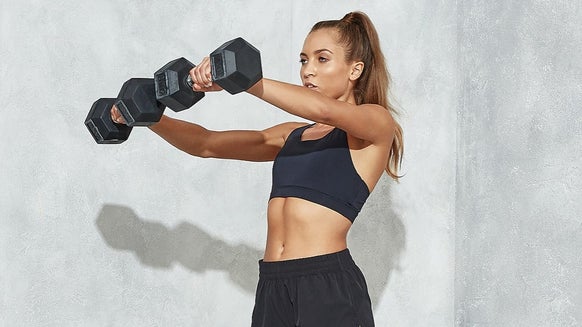
Unless you’ve been living under a rock — or without Instagram, which is basically the same thing — then you’ve probably not been able to escape the HIIT hype. It seems like everywhere you turn people are singing the praises of this form of cardio, which is based on being short, but super-intense — but is it actually worthy of all the noise?
We spoke to Abigail Stacey (
), a physiologist at Nuffield Health who has a Sport and Exercise Science BSc., to get the 411 on this trending form of training.
What is HIIT?
First things first, let’s be clear what it is we’re talking about here. HIIT, or high-intensity interval training, is a form of working out that involves you giving your complete 100% maximum effort in quick, intense bursts of exercise, followed by short recovery periods.
Basically, it’s cardio that gets your heart rate through the roof and, therefore, blasting through fat.
How long should a HIIT workout be?
Now, this is arguably one of the biggest selling points of HIIT. Yes, it requires a lot of effort, and yes, it’s meant to push your body to its limits. However, it’s not meant to last long.
“The maximum time for HIIT can vary, but 30 minutes is the absolute maximum recommended duration. Anything above that can increase risk of injury.”
It can literally all be over in a matter of minutes — and it can be done anywhere, including your front room — which means waving goodbye to that “I don’t have time to go the gym” excuse.
When it comes to the exercises within a HIIT workout, most people generally go for a 2:1 or 3:1 approach, meaning 40/45 seconds of full-on exercise to 20/15 seconds of rest. Some choose to have an ‘active’ rest period too, rather than stopping completely — so they’d recover with an easy movement like walking or jogging on the spot.
Benefits of HIIT
1. It’s a full-body workout
Many of the exercises that make up the foundation of a HIIT workout use all the major muscle groups of the body — and boy, do you feel it. Using explosive movements in exercises like squat jumps, sprints, burpees, mountain climbers, and jumping lunges really gets your whole body working hard, not least your heart.
2. It boosts your metabolism
HIIT may over quickly, but it’s effects are long-lasting, as explained by Abigail.
“HIIT raises the thermogenic effect in the body, which increases the duration of time you burn calories throughout the day.”
Therefore, making the time for a quick HIIT session before you leave for work in the morning — which only has to mean waking up 15 minutes or so earlier than usual — could be an amazing way to kick-off your metabolism for the day.
3. Convenience
Okay, so we’ve touched on this already but it’s worth repeating. How many workouts can you complete in under 30 minutes, wherever you are, with no equipment necessary? And we’re talking effective workouts, people.
4. It gets you fitter, quicker
According to Abigail, making HIIT part of your workout regime can help to improve other areas of your training too.
“It’s been shown through many studies that HIIT can improve overall physical performance, because HIIT workouts can stimulate both the aerobic and anaerobic systems, whereas steady state training only utilises the aerobic system. That means your body can build up stamina and perform better in all your workouts, no matter what they are.”
Is HIIT suitable for beginners?
If you’re just finding your feet in the fitness world, or recovering from an injury, you should probably ease yourself in with a less intense form of cardio and gradually build yourself up to a HIIT workout.
Abigail says there’s a simple way of testing to see if you’re ready to take on the challenge;
“You should be able to sustain 65-75% of your maximum heart rate for 30 minutes before you start HIIT. This can be predicted through the calculation of 220 minus your age, e.g if you’re a 25-year-old, your maximum heart rate will be around 220 — 25 = 195.”
If you have a medical condition that is likely to be worsened by rapidly-increased heart rate you should always consult your doctor first.
Take home message
So, that’s the basics of HIIT — it’s not exactly a walk in the park, but if it’s something you’re willing to give a go, then the benefits can far outweigh the burn that comes with a set of burpees. It’s super-easy to mix up with different movements too, so once you get to grips with it, it’s great keep your workouts fresh.








